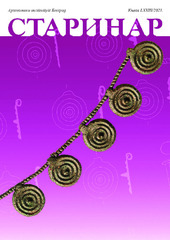Приказ основних података о документу
Preserving the Danube Limes in Serbia: A Review on the Biodeterioration of Trajan’s Bridge
| dc.creator | Unković, Nikola | |
| dc.creator | Nikolić, Emilija | |
| dc.creator | Ljaljević Grbić, Milica | |
| dc.creator | Jovičić, Mladen | |
| dc.date.accessioned | 2024-01-12T10:55:22Z | |
| dc.date.available | 2024-01-12T10:55:22Z | |
| dc.date.issued | 2023 | |
| dc.identifier.issn | 2406-0739 | |
| dc.identifier.uri | http://rai.ai.ac.rs/handle/123456789/1423 | |
| dc.description.abstract | One of the most significant monuments of the Roman Danube Limes is Trajan's Bridge, built in the period from 103 to 105 AD. The remains of the pillars on the Serbian bank of the Danube were partially restored four decades ago. Today, the pillar that is closest to the river, which has not undergone conservation, is subject to different types of deterioration. During the comparison between the present condition of the pillar and those recorded in photos over the last six decades, we can estimate that its level of material loss has not overly changed. However, the difference in biological growth is visible. The primary aim of this study was to record the degree of the infestation and endangerment of the monument and check for possible risks for future mortar deterioration where mortar is in direct contact with severely infested bricks. Moreover, a characterisation of the biodeteriogens was performed. Special emphasis was given to fungi as the main agents of deterioration. A precise assessment of the level of risk they pose to this monument was made as a basis for the formulation and implementation of appropriate conservation treatments. Severe macrofouling by epilithic lichenised fungi and mosses was documented. Even in areas where pillars lack visible infestation, thriving microbial communities characterized by the presence of various fungal structures, as well as structures of trichal Cyanobacteria, and Chlorophyta were recorded. Similarities between communities documented on brick, mortar, and stone surfaces estimated via Sørensen’s quotient of similarity, were high, with the highest similarity documented between mortar and stone. | sr |
| dc.language.iso | en | sr |
| dc.publisher | Beograd: Arheološki institut | sr |
| dc.relation | info:eu-repo/grantAgreement/ScienceFundRS/Promis/6067004/RS// | sr |
| dc.relation | info:eu-repo/grantAgreement/ScienceFundRS/Promis/6066210/RS// | sr |
| dc.rights | openAccess | sr |
| dc.rights.uri | https://creativecommons.org/licenses/by-nc-nd/4.0/ | |
| dc.source | Starinar | sr |
| dc.subject | biodeterioration | sr |
| dc.subject | Trajan's Bridge | sr |
| dc.subject | lichens | sr |
| dc.subject | Danube Limes in Serbia | sr |
| dc.subject | historical mortars | sr |
| dc.subject | historical brick | sr |
| dc.subject | historical stone | sr |
| dc.subject | Roman monument | sr |
| dc.title | Preserving the Danube Limes in Serbia: A Review on the Biodeterioration of Trajan’s Bridge | sr |
| dc.type | article | sr |
| dc.rights.license | BY-NC-ND | sr |
| dc.rights.holder | Arheološki institut, Beograd | sr |
| dc.citation.epage | 160 | |
| dc.citation.issue | LXXIII | |
| dc.citation.spage | 143 | |
| dc.identifier.doi | 10.2298/STA2373143U | |
| dc.identifier.fulltext | http://rai.ai.ac.rs/bitstream/id/4117/bitstream_4117.pdf | |
| dc.type.version | publishedVersion | sr |


